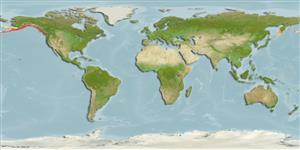Environment: milieu / climate zone / depth range / distribution range
Ecologia
marinhas demersal; intervalo de profundidade 0 - 225 m (Ref. 50610). Temperate; 66°N - 46°N
Northeast Pacific: Bering Sea to southern Puget Sound, Washington, USA.
Tamanho / Peso / Idade
Maturity: Lm ? range ? - ? cm
Max length : 8.3 cm TL macho/indeterminado; (Ref. 2850)
Descrição breve
Chaves de identificação | Morfologia | Morfometria
Espinhos dorsais (total) : 22; Raios dorsais moles (total) : 15; Espinhos anais: 0; Raios anais moles: 14 - 15. Dorsal spines and rays covered with skin; caudal rounded; pelvic fins partly attached to body (Ref. 6885). Color variable, changing rapidly; translucent pink to gray or brown on dorsal surface, lighter on fins; pectoral fins pale or bright orange; some dark spots on fins and vague darker markings on body; sometimes spotted; eyes orange (Ref. 6885).
Occurs in rocky areas, among sponges; also found on soft bottoms (Ref. 2850).
Life cycle and mating behavior
Maturities | Reprodução | Spawnings | Egg(s) | Fecundities | Larvas
Eschmeyer, W.N., E.S. Herald and H. Hammann, 1983. A field guide to Pacific coast fishes of North America. Boston (MA, USA): Houghton Mifflin Company. xii+336 p. (Ref. 2850)
Categoria na Lista Vermelha da IUCN (Ref. 130435)
Ameaça para o homem
Harmless
Utilização humana
Ferramentas
Relatórios especiais
Descarregue XML
Fontes da internet
Estimates based on models
Preferred temperature (Ref.
123201): 1.6 - 8.6, mean 5.6 °C (based on 233 cells).
Phylogenetic diversity index (Ref.
82804): PD
50 = 0.5005 [Uniqueness, from 0.5 = low to 2.0 = high].
Bayesian length-weight: a=0.00389 (0.00180 - 0.00842), b=3.12 (2.94 - 3.30), in cm total length, based on all LWR estimates for this body shape (Ref.
93245).
Nível Trófico (Ref.
69278): 3.2 ±0.5 se; based on size and trophs of closest relatives
Fishing Vulnerability (Ref.
59153): Low vulnerability (10 of 100).
